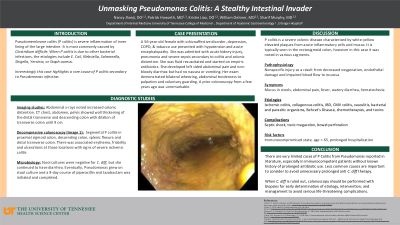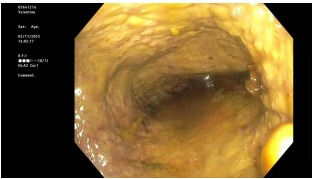Monday Poster Session
Category: Colon
P2064 - Unmasking Pseudomonas Colitis: A Stealthy Intestinal Invader
Monday, October 28, 2024
10:30 AM - 4:00 PM ET
Location: Exhibit Hall E

Has Audio

Nancy Jhanji, DO
University of Tennessee HSC COM Chattanooga
Chattanooga, TN
Presenting Author(s)
Nancy Jhanji, DO1, Patrick Howarth, MD2, Kristie Liao, DO2, William Oelsner, MD2, Sharif Murphy, MD2
1University of Tennessee HSC COM Chattanooga, Chattanooga, TN; 2University of Tennessee Health Science Center, Chattanooga, TN
Introduction: Pseudomembrane colitis (P colitis) is a nonspecific injury due to decreased oxygenation from impaired blood flow and endothelial damage. It occurs in various disease processes including infections, ischemia, microscopic colitis, chemicals, medications or inflammatory disease states.
Case Description/Methods: A 56-year-old female with a past medical history of schizoaffective disorder, depression, COPD presented with hypotension, and acute encephalopathy. She was admitted with acute kidney injury, pneumonia and severe sepsis secondary to colitis and colonic distention. No reported abdominal pain, distention or diarrhea prior to admission. She developed left sided abdominal pain, nonbloody diarrhea but no nausea or vomiting. Prior colonoscopy a few years ago was unremarkable. She was an active smoker and denied any alcohol or illicit drug use. On exam she had bilateral wheezing, abdominal tenderness to palpation and voluntary guarding. CT chest, abdomen, pelvis showed wall thickening of the distal transverse and descending colon with dilation of transverse colon until 9 cm. She was fluid resuscitated and started on empiric antibiotics. Stool cultures were negative for c diff but she continued to have diarrhea. Subsequent abdominal x rays noted increased colonic distention for which Gastroenterology was consulted and performed decompressive colonoscopy, revealing segmental P colitis in proximal sigmoid colon, descending colon, splenic flexure and distal transverse colon. There was associated erythema, friability and ulcerations at those locations with signs of severe ischemic colitis, which fit the picture of septic shock at initial presentation. PA grew on stool culture and a 9 day course of piperacillin and tazobactam was completed.
Discussion: P colitis is characterized by white-yellow elevated plaques from acute inflammatory cells and mucus. It is a severe colonic disease and pinpointing the underlying etiology is important so that appropriate interventions and antibiotics may be initiated. Most commonly seen with c. diff infection however in this rare case P colitis is seen with PA and ischemic colitis. When c. diff is ruled out with lab work and endoscopy, the differential should be broadened based on history. In terms of other infectious causes, sources include cmv colitis, parasites and bacteria causing bloody vs non-bloody diarrhea.

Disclosures:
Nancy Jhanji, DO1, Patrick Howarth, MD2, Kristie Liao, DO2, William Oelsner, MD2, Sharif Murphy, MD2. P2064 - Unmasking Pseudomonas Colitis: A Stealthy Intestinal Invader, ACG 2024 Annual Scientific Meeting Abstracts. Philadelphia, PA: American College of Gastroenterology.
1University of Tennessee HSC COM Chattanooga, Chattanooga, TN; 2University of Tennessee Health Science Center, Chattanooga, TN
Introduction: Pseudomembrane colitis (P colitis) is a nonspecific injury due to decreased oxygenation from impaired blood flow and endothelial damage. It occurs in various disease processes including infections, ischemia, microscopic colitis, chemicals, medications or inflammatory disease states.
Case Description/Methods: A 56-year-old female with a past medical history of schizoaffective disorder, depression, COPD presented with hypotension, and acute encephalopathy. She was admitted with acute kidney injury, pneumonia and severe sepsis secondary to colitis and colonic distention. No reported abdominal pain, distention or diarrhea prior to admission. She developed left sided abdominal pain, nonbloody diarrhea but no nausea or vomiting. Prior colonoscopy a few years ago was unremarkable. She was an active smoker and denied any alcohol or illicit drug use. On exam she had bilateral wheezing, abdominal tenderness to palpation and voluntary guarding. CT chest, abdomen, pelvis showed wall thickening of the distal transverse and descending colon with dilation of transverse colon until 9 cm. She was fluid resuscitated and started on empiric antibiotics. Stool cultures were negative for c diff but she continued to have diarrhea. Subsequent abdominal x rays noted increased colonic distention for which Gastroenterology was consulted and performed decompressive colonoscopy, revealing segmental P colitis in proximal sigmoid colon, descending colon, splenic flexure and distal transverse colon. There was associated erythema, friability and ulcerations at those locations with signs of severe ischemic colitis, which fit the picture of septic shock at initial presentation. PA grew on stool culture and a 9 day course of piperacillin and tazobactam was completed.
Discussion: P colitis is characterized by white-yellow elevated plaques from acute inflammatory cells and mucus. It is a severe colonic disease and pinpointing the underlying etiology is important so that appropriate interventions and antibiotics may be initiated. Most commonly seen with c. diff infection however in this rare case P colitis is seen with PA and ischemic colitis. When c. diff is ruled out with lab work and endoscopy, the differential should be broadened based on history. In terms of other infectious causes, sources include cmv colitis, parasites and bacteria causing bloody vs non-bloody diarrhea.

Figure: Pseudomembranous colitis
Disclosures:
Nancy Jhanji indicated no relevant financial relationships.
Patrick Howarth indicated no relevant financial relationships.
Kristie Liao indicated no relevant financial relationships.
William Oelsner indicated no relevant financial relationships.
Sharif Murphy indicated no relevant financial relationships.
Nancy Jhanji, DO1, Patrick Howarth, MD2, Kristie Liao, DO2, William Oelsner, MD2, Sharif Murphy, MD2. P2064 - Unmasking Pseudomonas Colitis: A Stealthy Intestinal Invader, ACG 2024 Annual Scientific Meeting Abstracts. Philadelphia, PA: American College of Gastroenterology.
